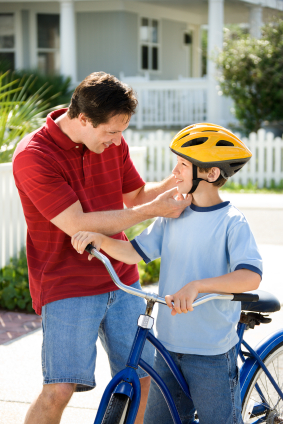Bug safety
- Don't use scented soaps, perfumes or hair sprays on your child.
- Avoid areas where insects nest or congregate, such as stagnant pools of water, uncovered foods and gardens where flowers are in bloom.
- Avoid dressing your child in clothing with bright colors or flowery prints.
- To remove a visible stinger from skin, gently back it out by scraping it off horizontally with a credit card or your fingernail.
- Combination sunscreen/insect repellent products should be avoided because sunscreen needs to be reapplied every two hours, but the insect repellent should not be reapplied.
- Use insect repellents containing DEET when need to prevent insect related diseases such as ticks which can transmit Lyme Disease, and mosquitoes which can transmit West Nile Virus and other viruses.
- The current CDC and AAP recommendation for children over 2 months of age is to use 10- 30 percent DEET. DEET should not be used on children under 2 months of age.
- The effectiveness is similar for 10-30% DEET but the duration of effect varies. Ten percent DEET provides protection for about 2 hours - 30% for about 5 hours - choose the lowest concentration that will provide required length of coverage.
- The concentration of DEET varies significantly from product to product, so read the label of any product you purchase. Children should wash off repellents when back indoors.
- As an alternative to DEET, Picaridin has become available in the U.S. in concentrations of 5-10%.
For more information on DEET, click here.
Playground safety
- The playground should have safety-tested mats or loose-fill materials (shredded rubber, sand, wood chips, or bark) maintained to a depth of at least 9 inches. The protective surface should be installed at least 6 feet (more for swings and slides) in all directions from the equipment.
- Equipment should be carefully maintained. Open "s" hooks or protruding bolt ends can be hazardous.
- Swing seats should be made of soft materials such as rubber, plastic or canvas.
- Make sure children cannot reach any moving parts that might pinch or trap any body part.
- Never attach-or allow children to attach-ropes, jump ropes, leashes, or similar items to play equipment; children can strangle on these.
- Make sure metal slides are cool to prevent children's legs from getting burned.
- Do not allow children to play barefoot on the playground.
- Parents should never purchase a home trampoline or allow children to use home trampolines.
- Parents should supervise children on play equipment to make sure they are safe.
Bicycle safety
- Do not push your child to ride a 2-wheeled bike until he or she is ready, at about age 5 or 6. Consider the child's coordination and desire to learn to ride. Stick with coaster (foot) brakes until your child is older and more experienced for hand brakes.
- Take your child with you when you shop for the bike, so that he or she can try it out. The value of a properly fitting bike far outweighs the value of surprising your child with a new one. For more information on finding the proper fit, go to http://www.aap.org/family/bicycle.htm#choosing.
- Buy a bike that is the right size, not one your child has to "grow into." Oversized bikes are especially dangerous.
- Your child needs to wear a helmet on every bike ride, no matter how short or how close to home. Many accidents happen in driveways, on sidewalks, and on bike paths, not just on streets. Children learn best by observing you. Set the example: Whenever you ride, put on your helmet.

- When purchasing a helmet, look for a label or sticker that says the helmet meets the CPSC safety standard.
- A helmet protects your child from serious injury, and should always be worn. And remember, wearing a helmet at all times helps children develop the helmet habit.
- A helmet should be worn so that it is level on the head, not tipped forwards or backwards. The strap should be securely fastened, and you should not be able to move the helmet in any direction. If needed, the helmet's sizing pads can help improve the fit.
Skateboard, scooter, in-line skating and Heelys safety
- Children should never ride skateboards or scooters in or near traffic.
- All skateboarders and scooter-riders should wear a helmet and other protective gear; wrist guards are particularly important.
- Communities should continue to develop skateboard parks, which are more likely to be monitored for safety than ramps and jumps constructed by children at home.
- While in-line skating or wearing Heelys, be sure to wear appropriate protective equipment and only skate on designated paths or rinks and not on the street.
Lawn mower safety
- Try to use a mower with a control that stops the mower from moving forward if the handle is let go.
- Children younger than 16 years should not be allowed to use ride-on mowers. Children younger than 12 years should not use walk-behind mowers.
- Make sure that sturdy shoes (not sandals or sneakers) are worn while mowing.
- Prevent injuries from flying objects, such as stones or toys, by picking up objects from the lawn before mowing begins. Have anyone who uses a mower wear hearing and eye protection.
- Do not pull the mower backward or mow in reverse unless absolutely necessary, and carefully look for children behind you when you mow in reverse.
- Always turn off the mower and wait for the blades to stop completely before removing the grass catcher, unclogging the discharge chute, or crossing gravel paths, roads, or other areas.
- Do not allow children to ride as passengers on ride-on mowers.








